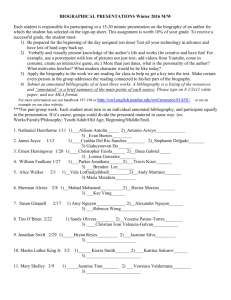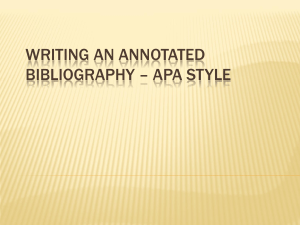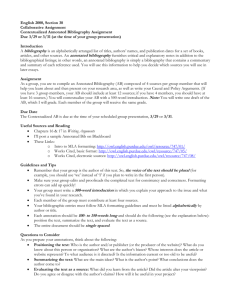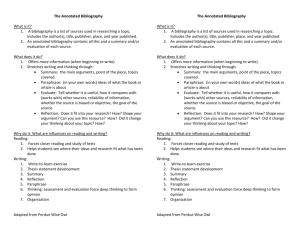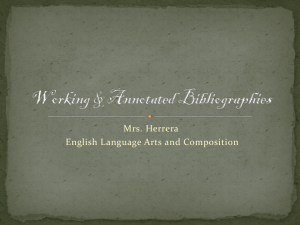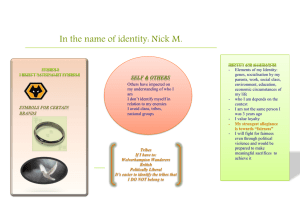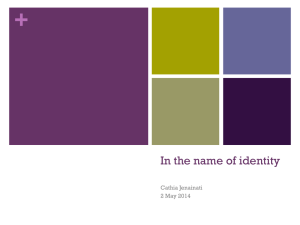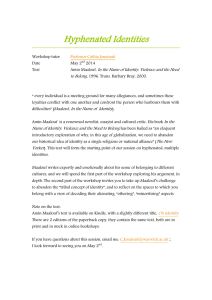In the name of Identity
advertisement
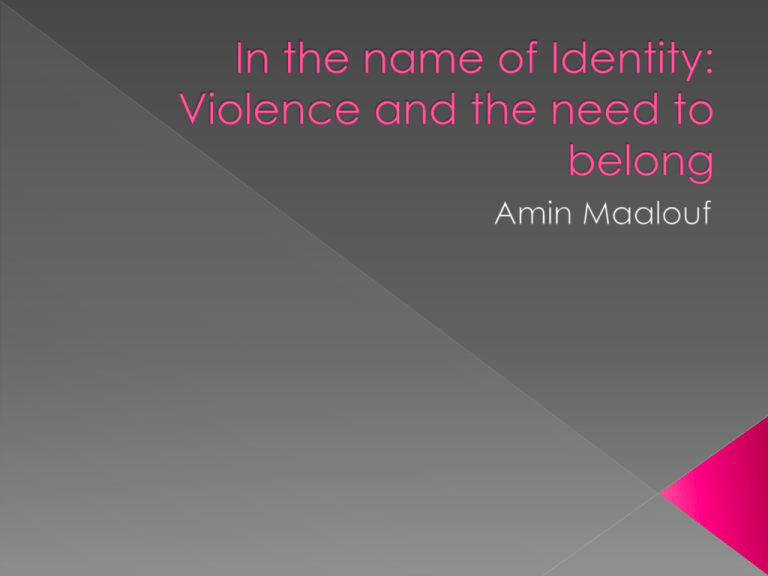
Peer Writing We have accomplished: How to write a thesis statement How to make an argumentation How to appeal egos, pathos and logos How to gather information and do library research Today: How to edit our papers Workshop: Peer editing Book Discussion on Identity Part 1: Kayla and Kristen Background Information about the examples Maalouf uses in his book. Annotated Bibliography Born in 25 February 1949 in Beirut A Lebanese journalist and author Lives in France since 1976 Maalouf’s website: http://www.aminmaalouf.org/english/ An interview: http://www.youtube.com/watch?v=kagj l0uBxX4 Identity is what makes us unique: our background, our race, our language, our gender, our religion etc. One identity and several affiliations , or as he calls, a number of allegiances Reality: taking all the allegiances and His main aim is: “to try to understand why so many people commit crimes nowadays in the name of religious, ethnic, national or some other kind of identity,” how what he calls “identities that kill” are made and sustained. Us and them distinction—it can lead people to the worst kind of extremities It is good if you have multiple national allegiances and can live them altogether. Yet some are pressed hard to choose one side and be part of one or the other. Those German-Turk, FrenchAlgerian, etc… MAIN QUESTION: We want to try to understand why so many people commit crimes nowadays in the name of religious, ethnic, national or some other kind of identity? Former Yugoslavia Lebanon Rwanda World is unfortunately full of such examples. Maalouf specifically focus on Middle East and Balkans. After WWII Yugoslavia dissolved into Croatia, Macedonia, Bosnia and Herzegovina, Serbia, Kosovo During the Cold War, the Yugoslav government allied with the Soviet Union However, despite an early alliance of the Yugoslav communists with the Soviet Union, Stalin distrusted Tito and the two leaders did not agree with each others' methods. Frustration between Tito and Stalin grew after Tito refused to link Yugoslavia's economy with that of the Soviet Union and the rest of Eastern Europe. The relations between Tito and Stalin came to an end in 1948 It is bordered by Syria to the north and east, and Israel to the south. It is close to Cyprus through the Mediterranean Sea. Before the Lebanese Civil War (1975-1990), the country enjoyed a period of relative calm and prosperity, driven by the tourism, agriculture, and banking sectors of the economy. It was widely known as the "Switzerland of the East" due to its financial power and diversity. Lebanon attracted large numbers of tourists to the point that the capital Beirut became widely referred to as the "Paris of the East.” Two groups in Rwanda While the Hutu are generally recognized as the ethnic majority of Rwanda, in racialist ideology the Tutsi were identified as a foreign race, as opposed to an indigenous minority. The largest conflict related to this tension was the 1994 Rwandan Genocide mass killing of hundreds of thousands of Rwanda's Tutsis by the Hutu militia. A must-see movie:“Hotel Rwanda” Proposals due next Tuesday (October 28th) Read Part 1 AND 2 of “In the name of Identity” Moving with our research projects: Writing Annotated Bibliography—See the next slides. 1) Find two resources that are relevant to your research projects. 2) Post a short annotated bibliography (A short summary and reflection of the articles). If it is a web resource copy and paste it in your entry. If it is a journal article make sure that you cite them properly. A bibliography is a list of sources (books, journals, websites, periodicals, etc.) one has used for researching a topic. Bibliographies are sometimes called "references" or "works cited" depending on the style format you are using. An annotation is a summary and/or evaluation. Therefore, an annotated bibliography includes a summary and/or evaluation of each of the sources. Depending on your project or the assignment, your annotations may do one or more of the following: Adapted from OWL Purdue. For more information go to http://owl.english.purdue.edu/owl/resource/614/01/ Summary: What are the main arguments? What is the point of this book or article? What topics are covered? If someone asked what this article/book is about, what would you say? The length of your annotations will determine how detailed your summary is. Reflection: Once you've summarized a source, you need to ask how it fits into your research. Was this source helpful to you? How does it help you shape your argument? How can you use this source in your research project? Has it changed how you think about your topic? Identity Part 2 Class blog: Looking at your annotated bibliographies. Evaluating your sources Research in Progress: Writing a Research Proposal. Proposals are due next Tuesday. Late papers will NOT be accepted. Bibliographic citations usually include three main components: author(s), title, and publication information. You need to determine relevance and authority. This is one of the most important research skills in the research process. 1. Authority What are the author's qualifications? Is the document written on a topic in the author's area of expertise? Is the author affiliated with an institution? 2. Accuracy Does the article cite its sources? Are the conclusions justified and supported by evidence? Is the information reliable and free of error? 3. Comprehensiveness Are the topics explored in depth? Does the information appear to be valid and well-researched? Does the work update other sources? Is the information useful or repetitious? 4. Validity Does the author inform or persuade? Is the language free of emotion-rousing words or bias? Does the author express a particular point of view? 5. Ease of use Is the resource organized logically? Are the main points clearly presented? Tentative Title Research questions and Thesis Statement The significance and purpose of this research: Why is this important to you and to your audience? Discuss your interest and prior experience with this topic. Methods: What research methods will you be using to explore your topic? What are your primary and secondary resources? Audience Primary research: collecting a data of your own. Observations, interviews, photos, survey questions Secondary Research: reading the research results of others. Both See the handout on Kira’s research 1. 2. 3. Read Li’s research proposal. Discussion Questions: Can you clearly tell what Li Chen’s research question is? If you think it needs clarification, what suggestions would you make? What is the author’s purpose in researching this topic? Where does the author discuss the purpose, and what recommendations would you make for clarifying the purpose Who does the author intend to address with the final research process? What suggestions would you make to clarify the intented audience? Proposals due on Tuesday, October 28th Read Identity part 3 Identity Part 3 Presentations: Scott, Jake, Karel What is Globalization?—Class discussion on globalization. Data collection methods--REVISION Talking about your Research Proposals What is a Literature Review? A group of American tourists arrived in Italy not long ago. “Amazing!” one said to their tour guide, a friend of mine: “You have pizza here too.” A group of Japanese Boy Scouts landed in Chicago. “Amazing!” they told their troop leader. “They have McDonald’s here too.” http://magma.nationalgeographic.com/2000 /culture/global/main.html Write down your definition of globalization http://www.youtube.com/watch?v=ljbI363A2Q http://www.youtube.com/watch?v=iWzx BkszN8k&feature=related Literature review is a collection of materials on a topic. A literature review can be just a simple summary of the sources, but it usually has an organizational pattern and combines both summary and synthesis. A summary is a recap of the important information of the source, but a synthesis is a re-organization, or a reshuffling, of that information . Adapted from various online and paper based resources Literature reviews provide you with a handy guide to a particular topic. Literature reviews can give you an overview or act as a stepping stone in your research. Comprehensive knowledge on the topic is necessary as you write your research papers. Introduction: You should give a quick idea of the topic of your literature review, such as the central theme. Body: In this section of your paper, you should discuss your sources. You can organize your sources either chronologically, thematically, or methodologically Conclusion: Conclusions/Recommendations: Discuss what you have drawn from reviewing literature so far. Where might the discussion proceed? http://owl.english.purdue.edu/media/pd f/20070515025950_667.pdf Use quotes sparingly Remember to summarize and synthesize Keep your own voice Be careful when paraphrasing a source. Revise, revise, revise… Final Research paper (60) I) Research Proposal (1-2 pages): 5 points II) Literature Review (4-5 pages): 20 points III) Research Paper (7-10 pages): 35 points (also, your book reviews are worth of 15 points in total—see the syllabus for more information) Finish Identity Expand your resources (find current academic articles written on your topic) Don’t vote video: http://www.youtube.com/watch?v=0vtHwWReGU 0 Book Review due on Tuesday Writing Center workshop. We are meeting in Eicher Hall 218. Bring your resources with you! Writing Center’s website: http://www.wc.iup.edu/contactus.htm Presentations on the last part of Identity. Talking about Literature Review The genre of the book was very appropriate, because he used narrative examples to get the reader understand what he was going through. I feel that UN should read Covering. Not just to benefit them for work, but as an American citizen. Marks true self was revealed when he found love Save me was an intriguing film that kept the audience interested through out the film See this website: http://owl.english.purdue.edu/handouts/grammar/g_comma .html Book reviews are due next Tuesday (November 4th) Find sources for your research and bring them with you next Tuesday. Make sure that your absences are not excessive. See me next week if you are worried about your grade so far.
